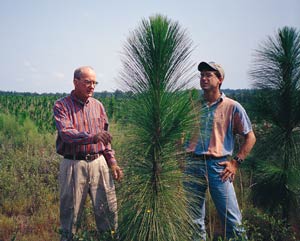Return Of The Longleaf Pine

The first settlers to arrive in Alabama observed an enormous forest of towering longleaf pines and hardwoods scattered across the grassy plains. Longleaf pines were prized for building log cabins and barns because of their length and straightness. But because of their numbers, they also were seen as an obstacle to expanding agriculture. Thousands of acres were cut, piled and burned during community log rollings to clear fields for corn, tobacco and other crops.Foresters estimate that 90 million acres of longleaf pine existed when the settlers arrived. Today, the longleaf forest of the Southeast has been reduced to less than 3 million acres.But the decline of this majestic tree may be over as more acreage is being planted thanks to financial incentives offered by the Conservation Reserve Program, the work of groups like The Longleaf Alliance and individual efforts by landowners like Dr. John Langford, a retired veterinarian from near Rose Hill in rural Covington County.Dr. Langford said his love affair with the longleaf pine began in 1953 when he purchased a tract of timberland that had longleaf pines growing on it. Since then, Langford has planted over 400 acres in longleaf seedlings.”I planted my first longleaf seedlings on poor, sandy land at the recommendation of a forester. He said longleaf would do better on this type soil. I questioned him at first, but he was right. I’ve been planting them ever since,” said Langford.Langford not only likes longleaf because of their natural beauty but also because of simple economics. “We sell timber by weight, and longleaf pine wood is heavier, and that means more income per acre. Also, longleaf are much more fire- and insect-resistant than loblolly,” said Langford.Langford smiles and shakes his head in disagreement when asked about the common belief that longleaf grows much slower than loblolly and slash pine. “That’s just not so with the longleaf I’ve planted on cut-over land,” he said. “It’s true, it takes the longleaf about two years to get out of the grass stage, but by the time it is six or seven years old, I’ve found it will be comparable in size to a loblolly planted the same year.”Mark Hainds, research coordinator with the Longleaf Alliance, nods affirmatively as Langford compares the longleaf growth rate to other pines.”I agree with what Dr. Langford said,” said Hainds. “On marginal to poor, sandy soil, the longleaf will have a comparable growth rate to loblolly. While it is true the loblolly will do better than longleaf on fertile soil, the longleaf growth rate can exceed loblolly on poor soils.”Hainds says the Longleaf Alliance, located at Auburn University’s Solon Dixon Forestry Education Center near Andalusia, was organized as a clearinghouse for information and education materials for landowners wanting to plant longleaf pines.”The Longleaf Alliance was the brain child of Rhett Johnson, Dean Gjerstad and several landowners interested in longleaf,” Hainds said. “One of our first jobs was to gather data to provide landowners interested in planting longleaf with a nursery and tree planters list. We also interviewed and analyzed information on the experiences of tree planters, nurserymen and landowners regarding their success and failures with planting longleaf. The Longleaf Alliance is funded by the 700 plus supporting member contributors,” he added.According to Hainds, the Longleaf Alliance has learned a lot about improving survivability when planting longleaf.”I investigated a lot of longleaf planting failures early on, especially those planted in pasture and agricultural sites. One of our big discoveries was that most people were planting longleaf too deep,” he said. “We can now contribute the primary reason of most long leaf planting failures to excessive planting depth followed by heavy competition from introduced grasses such as bermuda, bahia, fescue and other grasses. We have also found the survival rates of containerized seedlings to be considerably higher than bare root seedlings.”Langford and Hainds agree that it is critical that the terminal bud of the seedling remain above ground surface.”We planted longleaf similar to loblolly in the beginning because we didn’t know any better. The terminal bud was covered at planting, and the trees didn’t survive. In three years of test-plot experiments, we have proven this to be the most critical planting consideration,” said Hainds.”‘Sanding in’ is another big problem we have found in pasture or agricultural site plantings,” said Hainds. “By this I mean the seedling must be planted shallow enough to allow for some soil to drift in around the seedling and the bud still remain uncovered. We have found ‘sanding in’ to be more of a problem when using the scalping method. By scalping I am referring to peeling back the sod in rows 30 to 36 inches wide and 2 to 4 inches deep and planting the seedling in the scalped furrow. With proper spraying, scalping to reduce competition and using quality seedlings, the survival rate will go up considerably when planting in pasture or agricultural sites,” he added.Hainds says competition is much easier to control in cut-over sites.”We recommend spraying once with a Velpar/Oust mixture from mid March through April in cut-over land. In pasture and agricultural sites, it is better to spray twice after planting,” Hainds said. “Apply herbicides during March or April to kill broadleafs and again after the grasses move in.”With the continuing research of organizations like the Longleaf Alliance, CRP incentives, and advocates of the longleaf pine like Dr. John Langford, we may once again see this stately pine covering much of Alabama.For information on planting longleaf pines, contact the Longleaf Alliance, Rt. 7 Box 131, Andalusia, AL 36420, or by phone at (334) 222-7779. Landowners may also find helpful information at the Alliance’s website, www.longleafalliance.org.Ben Norman is an outdoor writer from Crenshaw County.
